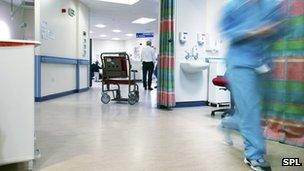Hospital deaths warning 'ignored'
- Published

Sir Brian said he had fought to bring the issue to the attention of senior NHS officials
More than 20,000 hospital deaths could have been prevented if warnings about high mortality rates had been acted on quickly, a government adviser has said.
Professor Sir Brian Jarman has accused ministers and officials of ignoring data on high death rates for a decade.
Sir Brian is working on the government review of 14 hospital trusts with higher-than-average death rates in the wake of the Stafford Hospital inquiry.
The government said the inquiry report showed "failings across the system".
'Continuously high'
Sir Brian, director of the Doctor Foster research unit at Imperial College in London, has developed systems for monitoring death rates - known as hospital standardised mortality ratios (HSMRs) - and other data on a monthly basis.
He has been publishing such data for 12 years and it helped expose high death rates at Mid Staffs and the 14 trusts now under investigation.
Sir Brian, a former GP and former president of the British Medical Association, said he fought to bring the issue of high mortality rates to the attention of senior NHS officials - but he was ignored.
"For the last 10 years there were about four [hospitals] who have had continuously very high adjusted death rates. And actually I sent to the Secretary of State in March 2010, Andy Burnham, a list of hospitals that had high [rates], and there are seven of the ones on the list that have just been mentioned," he told ≥…»ÀøÏ ÷ Radio 4's Today programme.
He said Mr Burnham replied in a note dated 24 March 2010 saying he had asked the Care Quality Commission (CQC) to study the data.
"He said he sent it to the CQC and they did not find that there was anything to worry them," said Sir Brian.
He added: "Well I think that it's a pity that he didn't because you have seen at Mid Staffs and we've seen at other hospitals that when they have actually gone in and looked they have been able to reduce the death rates.
"We are talking about people dying there."
Mr Burnham, who was health secretary between June 2009 and May 2010, said he acted "firmly and immediately" when Sir Brian contacted him.
"I acted immediately and passed the data to the independent regulator... and I also invited Brian Jarman on to a working party to look at this very issue. So I don't think it's possible to say we were complacent or that we ignored these warnings," said Mr Burnham, now shadow health secretary.
'Avoidable deaths'
Sir Brian said looking at data from the 14 hospital trusts listed as having high HSMRs, the "observed deaths exceeds the number they were expected to have by the national average".
He said the number of excess deaths at these trusts alone over the past 10 years amounted to "a bit over 20,000".
"That's only looking at 14 of the 140 trusts - there are likely to be other trusts where they have numbers that exceed the national value," he said.
He went on: "Those hospitals which had persistently high death rates over all those years and have now been listed for investigation should have been investigated earlier, because it is quite possible we would have had fewer deaths in those hospitals.
Sir Brian Jarman: "It would have been easy to improve things"
"I think there must be at least tens of thousands of avoidable deaths in those hospitals alone, when we should have been going in and we should have been looking at them."
The CQC said: "The mortality data from the Dr Foster Unit at Imperial College London was taken into account when these services were registered with the CQC in April 2010.
"The CQC currently analyses a wide range of indicators to inform its regulatory activities and mortality measures are an important part of this. CQC is changing the way it inspects hospitals this includes looking at how it uses data."
Last month a report on Mid Staffs by Robert Francis QC said "fundamental change" was needed to prevent in the NHS. It came after data showed there were between 400 and 1,200 more deaths than would have been expected.
The Department of Health said the report showed failings across the system, including by the department.
It pointed out that it had already apologised and was now leading the inquiry into other trusts with apparently abnormally high death rates.
- Published6 March 2013
- Published3 February 2012